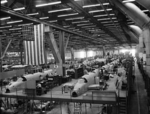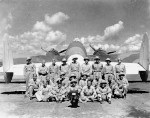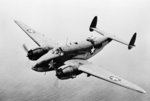Ventura
| Country | United States |
| Manufacturer | Vega Aircraft Company of Lockheed Corporation |
| Primary Role | Medium Bomber |
Contributor: C. Peter Chen
ww2dbaseDeveloped from the Hudson design was a new aircraft design that operated under different designations with the British Royal Air Force, United States Army, and the United States Navy. The new design had a similar layout as their Hudson predecessors, but they were larger and heavier.
ww2dbaseWith the RAF, the Ventura G.R.V. aircraft were originally meant for use as daylight bombers. In Feb 1940, the British ordered 675 aircraft. They were first delivered in Sep 1941, and flew their first combat mission on 3 Nov 1942 against a factory in Hengelo in the Netherlands. As the United Kingdom placed further orders, only a small number were delivered as many aircraft from the order were diverted to the United States Army after the US had entered WW2. On 6 Dec 1942, 47 of them were engaged in a daylight low-altitude bombing attack against Eindhoven, the Netherlands. In missions such as the attack on Eindhoven, it was discovered that Ventura aircraft were extremely vulnerable to enemy interception; in the 6 Dec 1942 raid, for example, 9 of the 47 bombers were shot down by German fighters. RAF leadership attempted to change Ventura's role to medium-altitude bombers to resolve the issue. On 3 May 1943, 10 New Zealand Ventura aircraft were launched to attack a power station at Amsterdam, the Netherlands; all 10 were lost to German fighters. By summer 1943, most remaining Ventura aircraft were replaced by Mosquito aircraft for bombing missions; their last bombing mission was flown by No. 21 Squadron RAF on 9 Sep 1943. Ventura aircraft were then transferred to Coastal Command with the new designation Ventura G.R.I. and served as patrol aircraft.
ww2dbaseThe Royal Australian Air Force operated 55 Ventura aircraft in the South Pacific, primarily in New Guinea.
ww2dbaseThe Royal Canadian Air Force was given its first Ventura aircraft on 16 Jun 1942. Eventually, 8, 113, 115,145, and 149 squadrons received them; Training programs at Trenton, Ontario and Pennfield Ridge, New Brunswick received several aircraft as well. The 286 Canadian Ventura aircraft mainly served in coastal patrol missions.
ww2dbase135 Ventura aircraft were assigned to the South African Air Force. They were mainly used to protect shipping around the Cape of Good Hope against German raiders and to attack Italian shipping in the Mediterranean.
ww2dbaseThe Royal New Zealand Air Force began operating Ventura aircraft in Aug 1942 when No. 487 Squadron RNZAF in Europe received them. In the Pacific, 139 Ventura aircraft were in New Zealand service. On 24 Dec 1943, during an air-sea rescue patrol mission, a New Zealand Ventura aircraft was attacked by 9 Japanese fighters; in an unexpected manner, the Ventura aircraft, known to be extremely vulnerable to hostile fighters, claimed three Japanese fighters shot down and two probables and returned home safely, albeit heavily damaged. In late 1944, New Zealand Ventura aircraft began to be phased out of front line action. On the final day of the Pacific War, only 30 of them remained on the front lines.
ww2dbaseWhen the war began for the United States, the US Army seized 264 Ventura aircraft being constructed for the RAF. They were designated B-34 Lexington (with original specifications) and B-37 (with less powerful 1,700-horsepower Wright R-2600-13 radial engines) bombers. The US Army ultimately only accepted 18 of the 550 units ordered for service before turning them over to the US Navy.
ww2dbaseThe US Navy operated them as PV-1 Ventura aircraft. They were equipped with ASD-1 search radars, at the expense of reduced forward defensive armament, for their intended role as patrol bombers. Later variants addressed the weakened defensive armament problem by eliminating the bombardier stations in their noses, placing three 12.7-millimeter machine guns in each aircraft instead. Some of them were also modified to carry eight 127-millimeter HVAR rockets under the wings. The first PV-1 Ventura aircraft was delivered in Dec 1941, and they first entered service in Feb 1943. They flew strikes against Japanese bases at Paramushiro and Shimushu in the Kurile Islands starting in Apr 1943. At times, they would serve as the leading aircraft for formations of US Army B-24 Liberator bombers because PV-1 Ventura aircraft were equipped with radar. A number of them were modified as nightfighters in late 1943 and served in the Solomon Islands. Toward the end of the war, a number of the PV-2 Harpoon variant aircraft were built, which had a greater bomb load capacity, among other enhancements.
ww2dbaseAfter the war, the US Navy sent its PV-1 Ventura aircraft to the Naval Air Station Clinton, Oklahoma, United States for scrapping; the Royal Canadian Air Force kept these aircraft in active service until 18 Apr 1947, the Royal New Zealand Air Force until 1948, and the South African Air Force until 1960. The firm Howard Aero in San Antonio, Texas, United States converted post-war surplus Ventura aircraft into civilian versions in the 1950s and 1960s, many as luxury passenger aircraft. They were known as either Super Ventura (earlier conversions), 350 (1960s conversions), 500 (with pressurized chamber), or Eldorado 700 (with longer wings, a pointed nose, and streamlined engine cowlings).
ww2dbaseSource: Wikipedia.
Last Major Revision: Sep 2010
Ventura Timeline
| 16 Jun 1942 | The Royal Canadian Air Force began operating Ventura aircraft. |
| 3 Nov 1942 | British Ventura aircraft flew their first combat mission against a factory in Hengelo in the Netherlands. |
| 6 Dec 1942 | 47 British Ventura aircraft bombed Eindhoven, the Netherlands; 9 bombers were lost. |
| 3 May 1943 | 487 Squadron of the New Zealand air force attacked a power station in Amsterdam, the Netherlands. All 10 bombers dispatched were lost to German fighters. Squadron Leader Leonard Trent won the Victoria Cross for his leadership in this attack. |
| 9 Sep 1943 | The British Ventura bombers flew their last bombing mission; they would soon be replaced by Mosquito aircraft. This last mission was flown by crews of the No. 21 Squadron RAF. |
| 18 Apr 1947 | The Royal Canadian Air Force retired its fleet of Ventura aircraft. |
SPECIFICATIONS
PV-1 Ventura/B-34 Lexington
| Machinery | Two Pratt & Whitney R-2800 geared radial engines rated at 2,000hp each |
| Armament | 4x12.7mm Browning M2 machine guns, 2x7.62mm M1919 Browning machine guns, 1,400kg of bombs or 6x147kg of depth charges or 1x torpedo |
| Crew | 6 |
| Span | 20.00 m |
| Length | 15.70 m |
| Height | 3.60 m |
| Wing Area | 51.20 m² |
| Weight, Empty | 9,160 kg |
| Weight, Loaded | 14,000 kg |
| Weight, Maximum | 15,000 kg |
| Speed, Maximum | 518 km/h |
| Speed, Cruising | 370 km/h |
| Rate of Climb | 15.40 m/s |
| Service Ceiling | 8,020 m |
| Range, Normal | 2,670 km |
| Range, Maximum | 4,200 km |
Photographs
 |  |  |  |
Please consider supporting us on Patreon. Even $1 per month will go a long way! Thank you. Please help us spread the word: Stay updated with WW2DB: |
Visitor Submitted Comments
12 Apr 2017 11:19:03 AM
I have a question regarding crew arrangement. The B-34 Lexington I've seen has either 5 or 6 crew depending on where you look. I want to know if they had more than one trained pilot per plane or if they only had the single pilot.
8 Sep 2017 06:09:45 AM
Despite its similarity to the Hudson, another Lockheed aircraft seeing service with some success in RAF Coastal Command, the Ventura was initially intended to be a replacement for the Bristol Blenheim. However the Ventura had many strong critics in Bomber Command and the general view was it could do nothing more than the Hudson and used more fuel. Because of its rather porcine fuselage it was quickly dubbed ‘The Flying Pig’ or just plain ‘Pig’. The Ventura proved to be not very successful on daylight bombing raids and by September 1943 it had flown its last mission for Bomber Command and was subsequently transferred to Coastal Command for maritime patrols.
19 Sep 2019 04:44:32 AM
Ventura Mk V No FP612 crashed in the desert near Hillah, Iraq on 25 April 1946 with the loss of all 4 aircrew.. It was serving with the Communications Flight at RAF Habbaniya. Source; RAF Form 1180.
14 Jan 2020 08:08:25 AM
459 RAAF Squadron operating along the Libyan coast with Hudson was re-equipped in December 1943 with the Ventura light bomber. It was flown with 5-man RAAF/RAF/RCAF crews for night bombing, anti-submarine & -shipping patrols in the Eastern Mediterranean theatre till mid-July when it was replaced by superior Baltimores.
All visitor submitted comments are opinions of those making the submissions and do not reflect views of WW2DB.
- » WW2DB's 20th Anniversary (29 Dec 2024)
- » Wreck of USS Edsall Found (14 Nov 2024)
- » Autumn 2024 Fundraiser (7 Nov 2024)
- » Nobel Peace Prize for the Atomic Bomb Survivors Organization (11 Oct 2024)
- » See all news
- » 1,150 biographies
- » 337 events
- » 44,162 timeline entries
- » 1,243 ships
- » 350 aircraft models
- » 207 vehicle models
- » 376 weapon models
- » 123 historical documents
- » 260 facilities
- » 470 book reviews
- » 28,657 photos
- » 431 maps
Fleet Admiral Chester W. Nimitz, 16 Mar 1945
Please consider supporting us on Patreon. Even $1 a month will go a long way. Thank you!
Or, please support us by purchasing some WW2DB merchandise at TeeSpring, Thank you!
9 Apr 2012 08:15:52 AM
Cannot locate a Roll oh Honour for crews who died on this operation and in particular crews of the Feltwell Venturas. Thank you EP